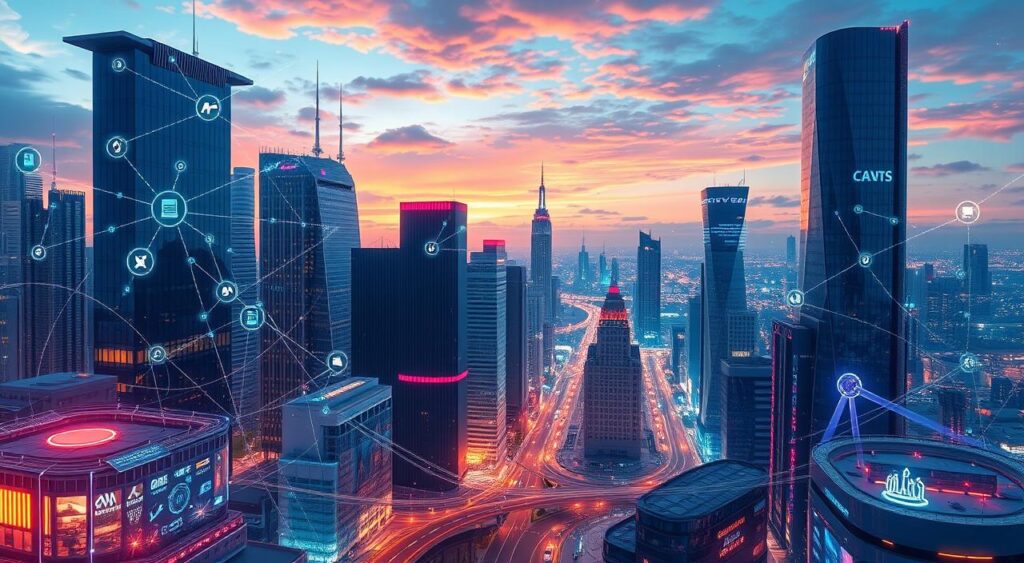Did you know the global Internet of Things (IoT) market is set to hit $1.1 trillion by 2026? This huge growth shows how IoT is changing our lives. It connects devices and objects to the digital world, making our homes and cities smarter. IoT brings us a new world of computing and making decisions with data.
IoT devices, from simple thermostats to complex machines, are at its core. They have sensors, software, and can connect to the internet. These devices talk to each other, share data, and work on their own. This is changing industries like manufacturing, healthcare, and agriculture.
In businesses, IoT devices track things like temperature and energy use. This helps companies make better decisions in real-time. It leads to better efficiency, saving money, and happier customers in many areas.
Key Takeaways
- IoT connects everyday objects to the digital world, enabling data-driven insights and automation.
- IoT has a transformative impact on industries like manufacturing, healthcare, agriculture, and smart cities.
- IoT devices monitor a range of parameters to drive efficiency, cost savings, and improved customer experiences.
- Emerging technologies like sensors, connectivity, cloud computing, and analytics enable the IoT revolution.
- Challenges in IoT include security, privacy, interoperability, and regulatory compliance.
Understanding the IoT Revolution
The Internet of Things (IoT) started with RFID technology for tracking goods. It grew into machine-to-machine (M2M) communication, where devices talk directly to each other. Today, IoT systems include sensors, actuators, and ways to connect and process data. This change is leading to a new era in business, moving from making things to offering services.
Evolution from RFID to Modern IoT
IoT began with RFID for tracking items. Now, it uses many sensors and ways to connect and process data. This has opened up many new uses for IoT.
Core Components of IoT Systems
IoT systems have sensors to gather data and actuators to control devices. They also use networks to send data and platforms for analysis. These parts work together to offer smart solutions in many fields.
The Impact on Digital Transformation
IoT is key to the Fourth Industrial Revolution, changing how businesses work. It helps gather data, leading to smarter systems and services. This change helps companies improve operations, customer service, and find new ways to make money.
The number of IoT devices is growing fast, thanks to 5G and IoT and AI coming together. This is changing fields like smart cities, healthcare, and farming. IoT makes systems work better in real-time, making them more efficient. It’s changing how we live and work, from managing energy to farming more precisely.
Essential Components of IoT Architecture
The Internet of Things (IoT) is a network of devices, sensors, and systems. They work together to collect, send, and process data. At the heart of this network are key components that make IoT systems work smoothly.
Sensors and actuators are the base of IoT architecture. They collect data and carry out actions as programmed. Devices like temperature detectors and smart locks send information through the network.
Connectivity is key in IoT systems. They use Wi-Fi, Bluetooth, and other protocols to send data. This layer makes sure data gets to where it needs to go for analysis.
Data processing is crucial in IoT. It involves analyzing the data collected. This can happen at the edge or in the cloud, where data is processed and learned from. The data layer turns raw data into useful insights and actions.
The user interface and application layer let users interact with IoT systems. This can be through apps, web dashboards, or voice assistants. It makes sure users can control and get updates from the IoT network easily.
By combining sensors, actuators, connectivity, data processing, and user interfaces, IoT architecture becomes a full system. It can gather, send, analyze, and act on real-world data. This leads to better efficiency, optimization, and decision-making.
Internet of Things: Fundamentals and Infrastructure
The Internet of Things (IoT) is changing our world. It connects many sensors, devices, and systems. At its heart is the IoT infrastructure, which makes data collection, communication, and cloud processing smooth.
Sensor Networks and Data Collection
IoT uses sensor networks to collect data from the world. These sensors are placed to get information like environmental conditions and asset performance. The data is sent through communication protocols, forming the IoT system’s backbone.,
Communication Protocols and Standards
IoT needs seamless connectivity. Many communication protocols and standards have been developed. They help devices talk to each other and to the cloud. Technologies like Wi-Fi, Bluetooth, Zigbee, and LoRaWAN make data transmission reliable and efficient for various IoT uses.,
Cloud Integration and Processing
IoT devices generate a lot of data. Cloud integration is key to using this data. Cloud platforms offer scalable storage, advanced analytics, and processing power. They help in getting real-time insights and making decisions automatically. This is vital for organizations to get useful information from their IoT projects.,
| IoT Infrastructure Component | Key Features |
|---|---|
| Sensor Networks | – Collect data from the physical world – Transmit data through various protocols – Provide real-time monitoring and visibility |
| Communication Protocols | – Enable device-to-device and device-to-cloud connectivity – Facilitate reliable and efficient data transmission – Cater to diverse IoT applications |
| Cloud Integration | – Provide scalable storage and processing – Enable advanced analytics and real-time insights – Support automated decision-making |
Using these IoT infrastructure components, organizations can fully use connected devices. They can drive digital transformation and create new solutions. These solutions can change industries and improve lives.,
Smart Home Automation and Connected Living
The Internet of Things (IoT) has changed how we see our homes. Smart home automation uses IoT devices to make our lives easier, save energy, and keep our homes safe. With smart thermostats, lights, and voice assistants like Amazon Alexa or Google Home, we can control our homes from anywhere. This lets us make our homes just the way we like them.
Smart thermostats can cut energy use by 10% to 15%. Smart lights can save 7% to 27% of energy. Home automation can also cut carbon emissions by 13%, with cities like Nottingham, UK, seeing a 26% drop since 2005. Homeowners might save 5% to 22% on their energy bills, depending on how much they automate.
The cost of smart home systems varies a lot. Basic setups cost US$300 to US$500. More advanced systems with security and lights can cost US$1,000 to US$5,000. Detailed projects, like smart water sensors and home theaters, can cost up to US$10,000. As technology gets better, AI and ML make these systems even more useful.
While smart home systems cost a lot upfront, they offer many benefits. They save energy, make homes more comfortable, and improve security. This makes them a great choice for those wanting a more connected home. But, there are also worries about security and privacy.
A report by Parks Associates found 55% of people worry about their smart home’s security. 72% are concerned about their personal data. To fix these issues, a new smart home standard called Matter was launched in November 2022. It’s backed by big names like Amazon, Apple, and Google. It aims to make smart devices work better together and be safer.
Using Zigbee and Z-Wave can also make smart home networks more reliable and secure. As the smart home market grows, making sure these systems are safe and easy to use is key. This will help more people enjoy the benefits of connected living.

Industrial IoT Applications and Manufacturing
The industrial Internet of Things (IIoT) is changing the manufacturing world. It brings smart, connected, and efficient operations. The IIoT market is expected to reach $33 billion by 2027.
Up to 40% of workers do repetitive tasks that can be automated. IIoT is making predictive maintenance, supply chain optimization, and factory automation possible. These changes are revolutionizing how businesses work.
Predictive Maintenance Systems
Predictive maintenance is a big change for manufacturing. 82% of companies have faced downtime in the last three years. The average downtime is four hours, costing about $2 million.
IIoT helps avoid downtime and improve workflows. IIoT sensors collect data on machine performance. They detect anomalies, helping with predictive maintenance and improving efficiency.
Supply Chain Optimization
IIoT is also changing supply chain management. IoT in manufacturing could add $1.2 to $3.7 trillion to the economy by 2025 (McKinsey report). 78% of supply chain leaders want technology to improve efficiency and automate tasks.
Real-time IoT monitoring can cut energy costs by almost 40% (Armal).
Factory Automation Solutions
IIoT is making factory automation solutions a reality. Automation through IIoT can lower costs, increase productivity, and improve quality. It also makes work safer for employees.
Manual quality control is prone to errors. IIoT helps oversee the manufacturing process, reducing mistakes. McKinsey says digitization and automation in manufacturing cut deviations by over 65%.
IIoT in manufacturing brings big benefits. Defects can harm a company’s reputation and lead to financial losses. Unplanned downtime can cost up to $260,000 an hour, costing about $50 billion annually for manufacturers (Industry EMEA).
IIoT solutions automate data collection. This reduces errors, improves accuracy, and gives valuable insights to businesses.
| IIoT Application | Potential Benefits |
|---|---|
| Predictive Maintenance |
|
| Supply Chain Optimization |
|
| Factory Automation |
|
IIoT is changing the manufacturing world, making it more efficient and profitable. IIoT sensors and data analytics are key to these changes. They enable real-time monitoring and informed decision-making. As the IIoT market grows, manufacturers that adopt these technologies will have a competitive edge and long-term success.
Healthcare Revolution Through IoT Technology
The healthcare industry is changing fast thanks to the Internet of Things (IoT). IoT brings new connected devices, wearable tech, and remote patient monitoring. By 2020, health-related IoT tech will be a $117 billion market. Wearables and apps help with fitness, health education, and tracking symptoms.
Precision medicine, made possible by IoT, uses genomics and omics for detailed data analysis. Electronic Health Records (EHRs) are quickly replacing old paper records.
IoT is changing healthcare in big ways. It helps with remote patient monitoring, better clinical workflows, and managing medication. It also keeps medical equipment running smoothly.
Remote patient monitoring lets us track vital signs like blood pressure and glucose levels in real-time. Smart wearables give us health data on the go, helping catch health issues early. IoT makes clinical workflows more efficient, saving time and resources.
The healthcare IoT market is growing fast, with a 17.8% annual increase expected from 2023 to 2028. It will reach a market volume of US$289.2 billion by 2028. IoT helps with remote patient monitoring, improving health outcomes and reducing hospital visits.
IoT is set to change healthcare for the better, making it more efficient and cost-effective. It will also make healthcare more accessible and personalized.
But, there are challenges like keeping patient data private and meeting regulations. Still, the benefits of IoT in healthcare are clear. More research and development are needed to keep improving healthcare delivery.
| IoT Applications in Healthcare | Benefits |
|---|---|
| Remote Patient Monitoring | Continuous tracking of vital signs, timely alerts and interventions |
| Clinical Workflow Management | Optimized inventory, patient allocation, and supply chain operations |
| Medication Management | Smart pill dispensers and reminders, data for medical professionals |
| Predictive Maintenance | Reduced downtime and delays of medical equipment |
The healthcare industry is embracing IoT to transform patient care and improve efficiency. Wearable devices track vital signs and activity levels, giving insights into health. IoT streamlines workflows, freeing up staff time for better patient care.
IoT leads to cost savings by optimizing resource use and reducing expensive treatments. It makes healthcare more accessible through telemedicine and remote monitoring. IoT helps manage drugs better, improving treatment plans and patient health.
The healthcare industry is ready to benefit from IoT, leading to better patient care and cost savings. As the market grows, IoT will change how we deliver medical care.
Smart Cities and Urban Development
The Internet of Things (IoT) is changing urban development. It’s making cities more efficient, sustainable, and livable. IoT is improving city infrastructure in many ways, like traffic management, public safety, and waste management.
Traffic Management Systems
IoT is leading the way in smart city traffic management. New York is testing connected vehicles to cut down on accidents and damage. Los Angeles uses smart traffic light controllers to improve traffic flow. London’s SmartPark project helps drivers find parking, reducing congestion.
Public Safety and Security
IoT is boosting public safety and security in cities. The NYC fire department uses data to spot crime hot spots and has a gunshot detection system. IoT devices quickly alert emergency services to accidents or fires, enhancing safety.
Waste Management Solutions
IoT is also changing waste management. East Brunswick, New Jersey, has a recycling app to boost recycling rates. MyNYCHA in New York helps manage repair tickets online. San Francisco uses solar bins for efficient waste collection, saving resources and cutting emissions.
IoT is key to making smart cities better and more sustainable. It’s improving traffic, safety, and waste management. IoT is shaping the future of cities and how we live in them.
IoT in Agriculture and Environmental Monitoring
The Internet of Things (IoT) has changed how we farm and monitor the environment. It brings new ways to farm precisely and manage resources better. IoT helps find harmful substances and pollutants, reducing harm to our planet. It also helps companies be more eco-friendly by improving how they work remotely.
In farming, IoT uses data to improve how we grow crops. It tracks soil moisture, weather, and crop health. This lets farmers make better choices, grow more, use less water, and harm the environment less. IoT farming aims to use resources wisely, cut costs, and farm in a greener way.
IoT is also key in watching over our environment. It gives us real-time data to act fast, no matter where we are. It checks water, air, energy, and toxic gases. This helps us manage and save resources better.
But, using IoT in farming and the environment has its hurdles. It’s not used much in farming because it’s complex, expensive, and only big companies can afford it. Also, poor internet in rural areas makes it hard to use IoT there.
Despite these challenges, IoT in farming and the environment offers hope. It uses data and connection to help us farm better and protect our planet.
Security Challenges and Privacy Concerns
The Internet of Things (IoT) is changing how we live and work. With more devices connecting, the risk of cyber attacks grows. By 2025, we’ll have 25 billion connected devices, making it easier for hackers to find vulnerabilities.
Events like the Mirai botnet attack show how IoT devices can be hacked. Weak passwords on devices like Ring cameras also let hackers in. These incidents show the dangers of not securing our devices well.
IoT systems are complex, with many devices and protocols working together. This complexity can lead to security gaps. Old devices often lack modern security, making it hard to keep everything safe. With more people working from home, IoT devices are at greater risk of being hacked.
Cybersecurity Threats
Cybercriminals target IoT devices with weak passwords and unpatched bugs. The Mirai botnet attack is a prime example of this. IoT devices also generate a lot of data, which can be hard to manage and keep secure.
Data Protection Measures
Keeping user data and devices safe is key for IoT’s success. Using network segmentation and regular checks can help protect against threats. Manufacturers must focus on security during development and keep devices updated to fight off new threats.
Privacy Compliance Standards
IoT devices collect a lot of data, raising privacy concerns. There’s a risk of eavesdropping and data misuse. Following privacy rules is crucial to protect user data and keep trust in IoT.
As IoT grows, we must focus on security and privacy. By using strong security, protecting data, and following privacy laws, we can make IoT safe and trustworthy for everyone.
Edge Computing and IoT Integration
As the Internet of Things (IoT) grows, edge computing is key to improving IoT systems. It processes data closer to where it’s made, cutting down on delays and data use. This is vital for tasks that need quick action.
Edge computing makes IoT systems more independent and efficient. It also boosts security by keeping important data local, not sending it to distant cloud servers.
Edge computing in IoT cuts down on delays, helps make quicker decisions, and saves on data use for companies. Edge devices can handle more tasks than usual IoT devices, offering local processing and quick insights for better work. It also cuts down on cloud costs by only sending needed data, reducing the need for big cloud setups.
IoT apps often act as monitors, collecting and analyzing data for smart actions. They work daily, hourly, or when needed. Edge computing helps IoT by reducing network traffic and delays for fast insights. It also saves bandwidth by only sending data that needs to be stored long-term.
Three main edge computing setups are Pure edge, Thick edge + cloud, and Thin edge + cloud. IoT edge computing has evolved to include pre-processing, data filtering, and more. Machine learning is key for analyzing data in IoT edge systems. IoT gateways support communication between devices and the cloud.
Edge computing spreads out workloads, making systems more reliable even when cloud links are down. It also boosts privacy and security by handling sensitive data locally, lowering the risk of data breaches. Edge computing also cuts down on delays, allowing for quicker responses and real-time analytics.
A mix of edge computing and cloud processing can offer the best results, saving costs. Digital twin tech at the edge helps manage assets and make better decisions, leading to more efficient operations.
In summary, combining edge computing with IoT is changing how data is collected, processed, and used. It brings real-time insights, better security, and more efficient operations.

The Role of AI and Machine Learning in IoT
Artificial Intelligence (AI) and Machine Learning (ML) are changing the game with the Internet of Things (IoT). They help make decisions smarter and predict what will happen next. These technologies make IoT systems more independent and efficient.
AI-powered IoT devices can learn from data, predict the future, and make choices on their own. This makes IoT systems smarter and more able to adapt to new situations and needs.
Predictive Analytics
AI and ML can look through lots of data from IoT sensors and devices. They find patterns and trends for predictive analytics. This lets IoT systems see problems coming, improve processes, and act ahead of time.
Automated Decision Making
AI-driven analytics engines work with IoT data in real-time. They find important insights and make decisions without needing a person. This makes things more efficient, cuts down on downtime, and boosts results.
Smart Device Intelligence
When AI meets IoT, we get smarter, more advanced IoT devices. These devices can adjust to new situations and needs. They use AI for things like seeing, understanding language, and keeping things running smoothly.
From self-driving cars to smart homes and industrial uses, AI and IoT are changing many fields. They lead to better decision-making.
As the IoT world grows, AI and ML will play a bigger part. They unlock the full power of connected devices and systems. The future looks bright with these technologies working together for a smarter, more efficient world.
IoT Business Applications and Value Creation
The Internet of Things (IoT) has changed how businesses work. It opens up new chances for innovation and adding value. IoT lets companies create innovative products and services, work more efficiently, and make customer experiences better.
IoT is used in many fields, like asset tracking and inventory management. It also helps in customer behavior analysis. The data from IoT devices gives companies useful insights. This leads to increased productivity, cost savings, and new revenue streams.
In manufacturing, IoT makes production better, predicts when things need fixing, and improves supply chain visibility. The smart city idea uses IoT to manage traffic, public safety, and waste management. It makes life better for city residents.
IoT solutions work across different areas, leading to success in many industries. As more devices connect to the IoT, its value will grow in many fields.
Businesses need to tackle security challenges and protect data to get the most from IoT. They also need to focus on standardization and integration for smooth IoT use.
As companies move forward in digital transformation, IoT will play a key role. It will drive innovation and shape the future of many industries.
Future Trends and Market Growth
The Internet of Things (IoT) market is growing fast. Experts say we’ll see a huge jump in connected devices by 2025. The global IoT market is expected to jump from USD 64.8 billion in 2024 to USD 153.2 billion by 2029, growing at 18.8% each year.
5G connectivity is a big reason for this growth. It makes data transfer faster and more reliable. This opens up new possibilities for IoT. Also, edge computing and blockchain will make IoT safer and more secure, boosting growth even more.
The IoT is changing many areas, from gadgets to factories. Smart manufacturing will grow a lot because it makes production more efficient and flexible. Platforms that manage IoT devices will also see a big increase in demand.
Asia-Pacific will lead the IoT market, thanks to fast tech progress in countries like China and Japan. Big names like AWS and Microsoft are growing by forming partnerships and launching new products.
As IoT grows, we’ll see more AI and ML. These technologies will make devices smarter and more connected. They’ll help with predictions and decisions, opening up new chances for businesses.
In short, the IoT market’s future looks bright. We’ll see more devices, faster growth in some areas, and new tech. Companies that adapt to these changes will do well in the future.
| Metric | Value | Year |
|---|---|---|
| Number of connected IoT devices | 18.8 billion | 2024 |
| IoT devices expected by 2030 | 40 billion | 2030 |
| Global IoT market size | $3.35 trillion | 2030 |
| Smart home systems in households | 400 million+ | 2025 |
| IoT security market size | $59.2 billion | 2028 |
| Healthcare IoT market size | $446 billion | 2028 |
Conclusion
The Internet of Things (IoT) has changed our world. It has brought us into a new era of digital change and a world more connected than ever. IoT lets us use technology in our daily lives to make things better, improve our lives, and tackle big global problems.
IoT has made our homes smarter, letting us control things from afar. It also makes industries work better by optimizing processes. With more IoT devices coming, like 1.23 billion smart home devices by 2027, IoT’s power to innovate and shake up markets is clear.
But, we must face challenges like security and privacy. Yet, IoT’s benefits in healthcare, transport, and monitoring the environment are huge. By using IoT, companies can get more done, work better, and make customers happier. This puts them ahead in today’s digital world.







